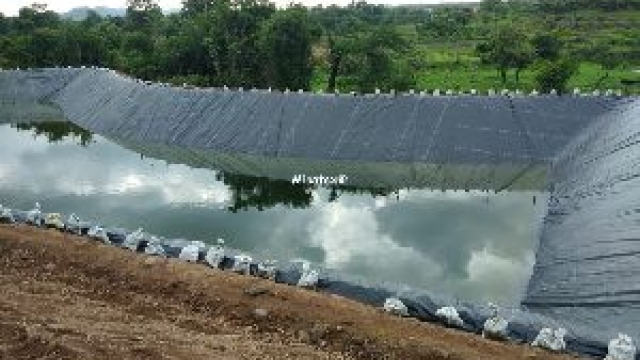
Geomembrane, a versatile and innovative solution, stands as a formidable shield against the numerous environmental challenges we face today. In an era where sustainability and protection of our natural resources are paramount, this engineering marvel provides an effective barrier to safeguard the environment from potential risks. Geomembrane, also known as "bpmgeomembrane," has gained recognition worldwide as the leading China geomembrane manufacturer and supplier since 2010. With its impressive track record, this acclaimed company has made significant contributions in ensuring the durability and reliability of geomembrane products.
Geomembrane acts as an impermeable protective layer, effectively preventing the passage of fluids or gases through various containment structures. Whether it’s for waste management solutions, water conservation, or even mining operations, geomembrane proves instrumental in mitigating potential environmental hazards. By creating a reliable barrier between potentially harmful substances and our delicate ecosystems, this technology offers an added level of protection and ensures the longevity of valuable resources.
Moreover, the manufacturing process of geomembranes involves utilizing advanced materials and industry-leading techniques. Through constant innovation and a commitment to excellence, bpmgeomembrane produces top-quality products that surpass international standards. With an extensive range of geomembrane options available, tailored to meet specific site requirements and individual project needs, this esteemed manufacturer consistently delivers solutions that exceed expectations.
As we navigate the complexities of an ever-changing world, it is essential to recognize the hidden strength of geomembrane. By implementing this remarkable technology, we can overcome daunting environmental challenges and work towards a more sustainable future. The collective efforts of manufacturers like bpmgeomembrane, alongside industry professionals and environmental advocates, pave the way for a world where protection and preservation of our planet take precedence. Together, let us embrace the power of geomembrane and build a resilient world that stands strong in the face of adversity.
Benefits of Geomembrane in Environmental Protection
Geomembrane, a versatile synthetic liner, has emerged as a crucial solution in safeguarding our environment against a myriad of challenges. With its diverse applications and exceptional properties, geomembrane acts as a protective shield, fortifying various environmental systems. Let’s explore the key benefits of this remarkable material.
-
Impermeability:
One of the fundamental advantages of geomembrane lies in its impermeable nature. This property enables it to create an effective barrier against the seepage and contamination of liquids and gases. Whether it is containing hazardous waste in landfills or preventing leakage in reservoirs, geomembrane acts as an impenetrable shield, ensuring the preservation of our environment. -
Versatility:
Geomembrane’s versatility allows it to be employed in a wide range of environmental protection projects. From lining ponds and canals to controlling erosion and managing waste, this material adapts to diverse applications with ease. Its flexible nature enables geomembrane to conform to the contours of the terrain, ensuring optimal coverage and protection. -
Durability:
With its exceptional durability, geomembrane serves as a long-lasting defense against environmental challenges. Its resistance to UV radiation, chemicals, punctures, and other potential threats ensures its longevity and effectiveness. By providing a robust and resilient barrier, geomembrane contributes to the sustainability and longevity of vital environmental infrastructures.
These inherent benefits of geomembrane make it an indispensable tool for environmental protection. Its impermeability, versatility, and durability combine to form a formidable defense, shielding our surroundings from the detrimental impacts of various challenges. As we continue to navigate an ever-changing world, the role of geomembrane in safeguarding our environment cannot be overstated.
###Applications of Geomembrane in Various Industries
The versatility of geomembrane has led to its wide application across various industries. From environmental protection to mining and agriculture, this remarkable material has proven to be a valuable asset in tackling different challenges. Let’s explore some of the key industries where geomembrane plays a vital role.
-
Environmental Protection: Geomembrane has become a cornerstone in environmental protection efforts. Its impermeable properties make it an ideal choice for lining landfills and preventing the leaching of harmful substances into the soil and groundwater. It acts as a barrier, safeguarding the environment from potential pollution and ensuring the long-term protection of valuable resources.
-
Water Management: The use of geomembrane is essential in water management projects. It is commonly employed in the construction of reservoirs, ponds, and canals to prevent seepage and leakage. By lining these structures, geomembrane helps in preserving water resources by minimizing loss through seepage, thus ensuring water availability for irrigation, drinking, and industrial purposes.
-
Mining and Energy: In the mining industry, geomembrane is utilized to line tailings ponds and containment facilities. By effectively isolating and managing mine wastes, it helps to minimize the risks of environmental contamination. Geomembrane is also employed in the construction and maintenance of oil and gas containment systems, providing a robust and secure barrier against potential leaks and spills.
-
Agriculture and Aquaculture: Geomembrane finds extensive usage in agriculture and aquaculture sectors. By lining irrigation canals and reservoirs, it aids in efficient water management, allowing for optimum utilization of water resources in arid regions. In aquaculture, geomembrane is utilized in the construction of ponds and tanks, preventing the loss of water while offering a controlled environment for fish rearing.
-
Civil Engineering and Construction: In civil engineering projects, geomembrane is employed in the construction of tunnels, dams, and underground storage facilities. It ensures effective waterproofing and prevents water seepage into these structures, enhancing their structural integrity and longevity.
-
Waste Containment: Geomembrane plays a crucial role in waste containment systems, such as hazardous waste landfills and industrial storage facilities. It acts as a reliable barrier, restricting the migration of contaminants into the surrounding environment, thereby safeguarding public health and minimizing any potential negative impact.
Geomembrane’s remarkable properties and adaptability make it an indispensable solution in various industries. Its applications extend far beyond these examples, catering to the ever-evolving challenges and demands of our modern world. As awareness of environmental issues and resource conservation increases, the significance of geomembrane usage is set to grow further in the years to come.
Advancements in Geomembrane Technology
Geomembranes have witnessed significant advancements in technology over the years, leading to improved performance and durability in various applications. These advancements have revolutionized the field and continue to contribute to the widespread usage of geomembranes as an effective shield against environmental challenges.
One notable advancement is the development of high-density polyethylene (HDPE) geomembranes. This type of geomembrane is highly resistant to chemical, biological, and physical stresses, making it an ideal choice for applications such as industrial waste containment, mining, and water management. The use of HDPE geomembranes ensures long-term stability and protection, offering enhanced durability in even the most demanding environments.
Another breakthrough in geomembrane technology is the introduction of geomembrane composites. These composites combine geomembrane materials with other geosynthetic components like geotextiles or geocomposites. The result is a versatile and multi-functional product that provides enhanced properties and performance. Geomembrane composites offer improved tensile strength, puncture resistance, and hydraulic conductivity, making them highly suitable for applications such as landfill liners, pond liners, and erosion control.
Lastly, significant advancements have been made in installation techniques, ensuring efficient and reliable deployment of geomembranes. Improved welding methods, such as hot wedge and extrusion welding, have made the installation process faster, more precise, and more robust. These techniques allow for effective seam formation, ensuring the integrity of the geomembrane liner. Additionally, advanced monitoring and quality control measures have been introduced to ensure the accuracy and effectiveness of the installation process.
Overall, the advancements in geomembrane technology have propelled the industry forward, providing solutions that meet the ever-increasing demands of environmental challenges. Through the development of high-density polyethylene geomembranes, the introduction of geomembrane composites, and the improvement in installation techniques, the efficacy and reliability of geomembranes have been significantly enhanced. These advancements underscore the vital role that geomembranes play as a barrier against various environmental issues, contributing to a sustainable and resilient future.






